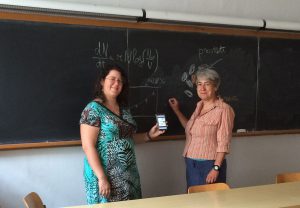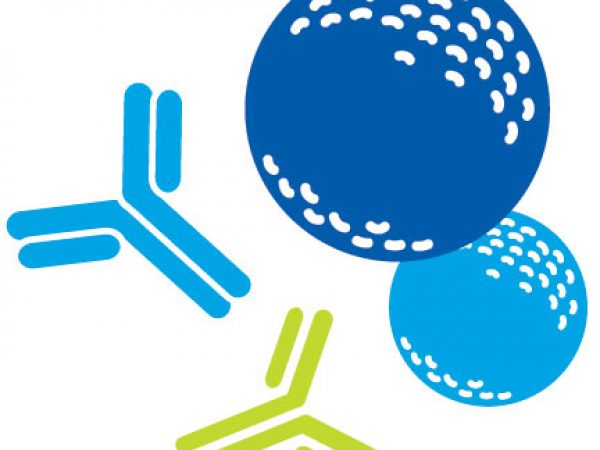An App to Predict Prostate Cancer Relapse?
A diagnosis of cancer is nerve-wracking. While cancer patients look to manage their situation with the help of health care providers and the support of their families and friends, a recent trend in lending support and guidance is the creation and use of health apps, such as those that can track appointments, log pain and other symptoms, or find a clinical trial that’s appropriate for one’s disease.
A team of mathematicians from Italy are developing an app that is more specific and may help in personalizing cancer therapy – the app can help prostate cancer patients and their doctors predict the time it might take for their cancer to reoccur after prostate cancer surgery.
The app is based on a mathematical model, which the team recently published in the AACR’s journal Cancer Research. The researchers are implementing their model into a mobile app called MyHealthAvatar.

Ilaria Stura and her mentor, Prof. Caterina Guiot, from the neuroscience department at University of Turin, Italy, are developing an app that can predict prostate cancer relapse.
MyHealthAvatar is a downloadable app that can help collect long-term health information, which can assist in making clinical decisions and personalized disease prediction and prevention. “We hope to integrate our mathematical model into the app to be used both by clinicians and patients for free,” says lead author of the study Ilaria Stura, a mathematician and a doctoral candidate in the Complex Systems for Life Sciences program at University of Turin, Italy.
To make this happen, Stura’s team is collaborating with the project manager of MyHealthAvatar, Feng Dong, PhD, who is a professor and head of the Center for Computer Graphics and Visualization at University of Bedfordshire. This project is sponsored by the European Commission’s Seventh Framework Programme.
“One in four patients who undergo prostate cancer surgery experiences a relapse. Predicting, and possibly preventing a relapse with adjuvant therapies is a major goal; however, overtreatment is a risk as well, because Androgen Deprivation Therapy (ADT) given after surgery, for instance, may promote the occurrence of new hormone-resistant tumor clones,” says Stura. “Algorithms that use easily obtainable biological data to accurately predict prognosis can help clinicians and patients make more informed choices.”
App would need just four PSA test results
Using four consecutive prostate-specific antigen (PSA) test results from a patient who had prostate cancer surgery, the math model can predict the time it might take for the disease to return.
The math model her team developed can potentially improve patient quality of life, Stura notes, because it can give valuable information to the urologist, for example, by reporting that the growth velocity of a patient’s tumor is increasing and that a relapse is expected within a certain number of months. With this information, the clinician could choose the best therapy for the patient (e.g., hormone therapy or radiotherapy) in order to stop the spread of the disease or, conversely, delay therapy if relapse is not indicated.
“Obviously, clinicians already try to do this based on their experience, but our method provides further confidence in their ‘investigational’ work, since the algorithm is validated based on data coming from a database much larger than his/her personal experience,” she says.
The science behind the app
In predicting the probability of prostate cancer relapse, the traditional approach is to use static parameters that include presurgery tumor characteristics such as Gleason score, tumor stage, and surgical techniques. To build their math model, Stura and her team instead used a dynamic model, which monitors fewer parameters but for a longer period time, following the history of the patient. The parameter they used in this study was PSA.
The team collected data from 3,538 patients who underwent surgery to remove prostate cancer. Of them, 728 had a relapse. Using multiple PSA values from each patient and data on survival outcomes, the researchers used a formula to estimate the parameter alpha (α), for patients who did and did not receive ADT.
The parameter α, first described by West and colleagues in a paper in Nature published in 2001, is defined as the ratio between the energy required by the cancer cell to survive and the energy it needs to replicate in order to create a new cell. The higher the rate of replication of a cancer cell, the greater its production of PSA; therefore, α represents the aggressiveness of the tumor cells, Stura explains.
Interpreting the data
The mathematicians found that four consecutive PSA values collected after surgery, α4, were enough to consistently predict the time to relapse. The higher the value of α4 was, the greater the probability of reoccurrence.
For example, for a patient who underwent prostate surgery and had not received any adjuvant ADT, an α4 value below 0.01 means there is an 82 percent probability that his cancer will not relapse within three years, and a 54 percent probability that his cancer will not relapse in four years. Conversely, an α4 value between 0.02 and 0.04 means there is a 71 percent probability that his cancer will relapse in two years, and a 95 percent probability that his cancer will relapse in four years. An α4 value greater than 0.04 means that there is an 87 percent probability that his cancer will relapse in a year and 93 percent probability that his cancer will relapse in two years.

The team further developed the algorithm for patients who receive ADT after prostate cancer surgery, in order to account for the fact that the treatment would cause the leftover cancer cells to die or not replicate rapidly to produce PSA.
“Our work is another small step toward personalized medicine, and shows how mathematics can be important to better understand tumor evolution,” Stura says. They are also collaborating with other mathematicians to explore using other growth models, such as the Gompertzian model, which is more reliable but requires extensive data preprocessing and more sophisticated mathematical tools, to fine-tune their product.



